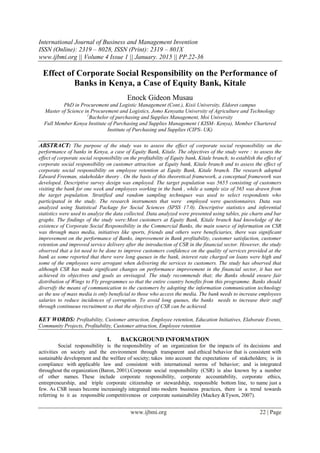The study investigates the impact of corporate social responsibility (CSR) on the performance of Equity Bank in Kitale, Kenya, focusing on profitability, customer attraction, and employee retention. Findings indicate that CSR initiatives improve bank performance, customer satisfaction, and employee retention, but issues such as long queues and high loan interest rates persist. The study recommends enhancing communication strategies, increasing employee salaries, and recruiting more staff to better realize CSR objectives.














![Effect of corporate social responsibility on the...
www.ijbmi.org 36 | Page
VI. ACKNOWLEDGEMENT
First and foremost my sincere gratitude goes to the almighty God for the gift of life, health, wisdom,
and strength that He granted me during the time of undertaking this study. I also extend my gratitude to
Fountain Cyber cafe for availing resources and more so their Academic Research Consultants who worked hand
in hand with me to make this work a success. Finally, to all the participants; that are the residents of Kitale town
Trans zoia County, I extend my sincere gratitude for taking part in this study.
REFERENCES
[1] Barnea A and Rubin A 2005, Corporate Social Responsibility as a Conflict between Shareholders, Social Sciences and Humanities
Research Council Canada, Journal of Economics and Management Strategy.
[2] Baron, D. 2001. ―Private politics, corporate social responsibility and integrated strategy,‖ Journal of Economics and Management
Strategy.
[3] Dean, L. K..(1999:Ties Between Corporate Social Performance and the Financial Bottom Line‖ Journal of Aplied
Psychology, vol . 82
[4] Friedman, M. (1970) ―The social responsibility of business is to increase its profits.‖
[5] Frooman, J. 1997. ―Socially Irresponsible and Illegal Behavior and Shareholder Wealth‖. Business and Society , 36(3):221-249.
[6] Hawkins,D.E,(2006).Corporate Social Responsibility; Balancing tomorrow‘s sustainability and today‘s profitability.4th
ed.Palgrave
Macmillan Ltd,New York.
[7] Jamali,D(2008).A stakeholder Approach to Corporate Social Responsibility.A fresh Perspective into Theory and Practice.Journal of
Business Ethics 82,213-231.
[8] Leonardo B, Rocco C and Hasan I 2007, Corporate Social Responsibility and Shareholder‗s Value: An Event Study
Analysis, Working Paper 2007 -6, Federal Reserve Bank of Atlanta
[9] Mackey A &Tyson M 2007, Corporate social responsibility and Firm performance:investor Preferences and corporate
strategies, Academy of Management Review, vol. 32.
[10] McWilliams A, and Siegel D 2001, Corporate Social Responsibility: A Theory of the Firm Perspective, Academy of Management
Review, 26, pp.117-127. 2007, An Empirical Analysis of the Strategic Use of Siegel D and Vitaliano D Corporate
Social Responsibility, Journal of Economics and Management Strategy, V 16.
[11] McWilliams A, and Siegel D 2001, Corporate Social Responsibility: A Theory of the Firm Perspective, Academy of Management
Review, 2007,An Empirical Analysis of the Strategic Use of Siegel D and Vitaliano D Corporate Social Responsibility,
Journal of Economics and Management Strategy, V 16(3), pp. 773-792.
[12] Moskowitz, M. (1972) ―Choosing socially responsible stocks.‖ Business and Society Review .
[13] Mugenda, O., & Mugenda, A. G. (1999). Research methods. Qualitative and Quantitative. Nairobi: Acts press.
[14] Orodho, A. (2009). Techniques of Writing Research Proposals and Techniques. Nairobi: Harlifax printers
[15] Turban, D. B., and D. W. Greening (1997) ―Corporate social performance and organizational attractiveness to prospective
employees.‖Academy of Management Journal, 40.
[16] Waddock, S. A., and S. M. Graves. (1997). The corporate social performance Financial performance link. Strategic Management
Journal .](https://image.slidesharecdn.com/d041022036-150205224613-conversion-gate02/85/Effect-of-Corporate-Social-Responsibility-on-the-Performance-of-Banks-in-Kenya-a-Case-of-Equity-Bank-Kitale-15-320.jpg)